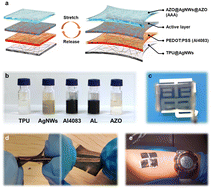Intrinsically stretchable, semi-transparent organic photovoltaics with high efficiency and mechanical robustness via a full-solution process†
Abstract
Intrinsically stretchable organic photovoltaics (is-OPVs) with high efficiency and transparency are a great challenge for wearable applications. Herein, we report a full-solution-processed device framework for semi-transparent is-OPVs. A ferroconcrete-like AZO@silver nanowire ((AgNWs)@AZO; AAA) composite forms the back stretchable transparent electrode (STE), which not only offers a 3D long-range pathway for efficient charge transport and collection but also reinforces interfacial stability. The OPV based on AAA exhibits a power conversion efficiency (PCE) of 12.83% with an average visible transmittance of 26.7%. Further, by employing thermoplastic polyurethane-embedded AgNWs as the front STE, the full-solution-processed semi-transparent is-OPV achieves a record PCE of 10.90%. The is-OPV also exhibits excellent mechanical robustness and retains 76.5% of initial PCE after 500 cycles of 10% stretch-release. This work sets a foundation for constructing a semi-transparent is-OPV via a full-solution process for wearable applications and skin-like electronics.



 Please wait while we load your content...
Please wait while we load your content...